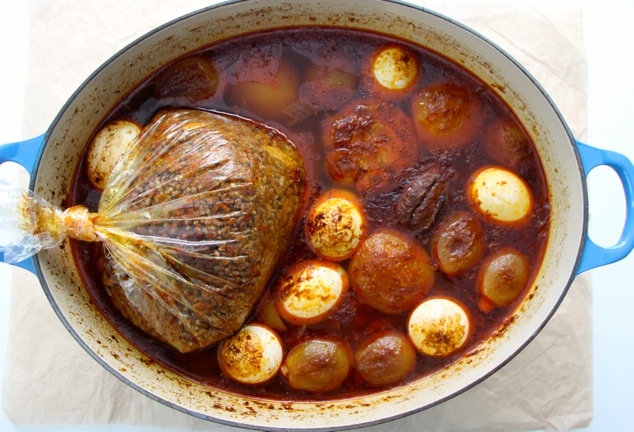 Hamin is a popular Israeli/Jewish dish associated with home and family gathering time. Hamin literally means heat and refers to its slow and long cooking method. True to its name, Hamin offers the warmth feelings of home and the coziness of a family gathering on that very special time of the week – Shabbat day.
Hamin is a popular Israeli/Jewish dish associated with home and family gathering time. Hamin literally means heat and refers to its slow and long cooking method. True to its name, Hamin offers the warmth feelings of home and the coziness of a family gathering on that very special time of the week – Shabbat day.
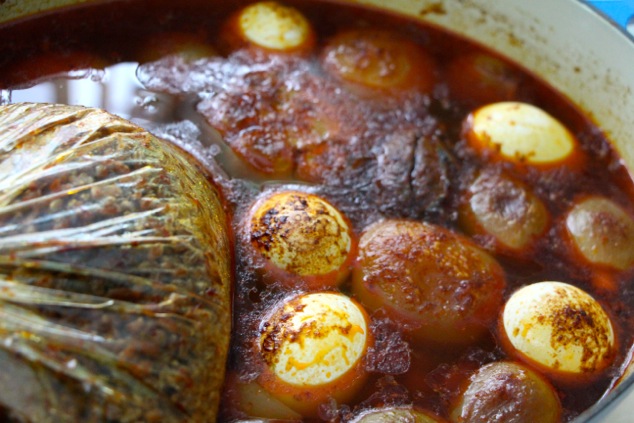 This dish has so much beauty and so many qualities: You see, Hamin is more than a delicious and satisfying dish on a winter day. It has an aroma that fills the whole house early in the morning, and is calling everybody to get together.
This dish has so much beauty and so many qualities: You see, Hamin is more than a delicious and satisfying dish on a winter day. It has an aroma that fills the whole house early in the morning, and is calling everybody to get together.
Hamin – in Hebrew, “Shabbat T’fina” in Tunisian, “Cholent” in Yiddish…
Hamin is not only unique to Tunisian culture and cuisine. The many different versions of Hamin show us a tradition that is being carried from generation to generation. Each unique recipe made out from the simple available ingredients of that place and time, offers to create this magical dish that brings us all together.
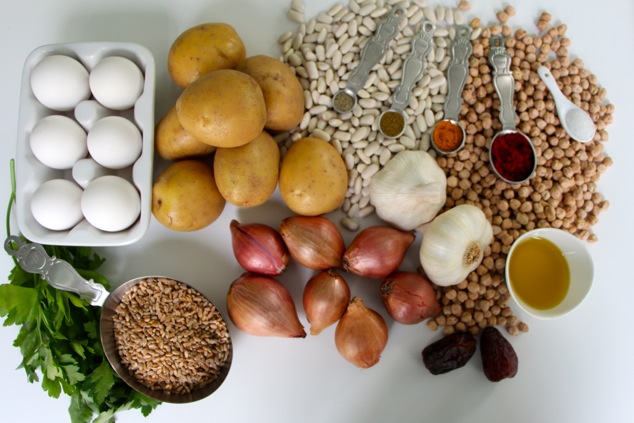 You will need:
You will need:
¼ cup Olive Oil
500 gr. (dry) Chickpeas (about 3 cups)
500 gr. (dry) White Beans (Cannellini) – medium size (about 3 cups)
8-10 small-medium Potatoes (butter potato/yellow potatoes)
8-10 medium Shallots
1 Garlic head
2 dried Dates
8 Eggs
1 tsp. Harissa (optional)
1 tsp. Black Peppers
1 tsp. Cumin
1½ tsp. Turmeric
1 tbsp. Sweet Paprika
1 tbsp. Salt
- Cast-Iron – Dutch Oven or other large oven proof pot.
(Mine is 9 1/2 QT. oval shaped pot)
For the “Hita” Wheat Berries Dish in a cooking bag
You will also need:
a Cooking bag
2 ½ cups Wheat Berries
3 Garlic cloves
½ chopped Shallot
1 tsp. Olive Oil
½ tsp. Black Pepper
½ tsp. Cumin
½ tsp. Turmeric
½ tsp. Sweet Paprika
1 tsp. Salt
3 cups Water
Fresh chopped Parsley
- I love this vegetarian Tunisian version of Hamin, but of course you can explore other versions. If you wish to create a meat version simply start this same recipe by searing stew meat pieces in the pot, remove them aside, follow the recipe and add them on top right after adding the beans to the pot. Continue to follow the recipe as is.
Let’s get to work:
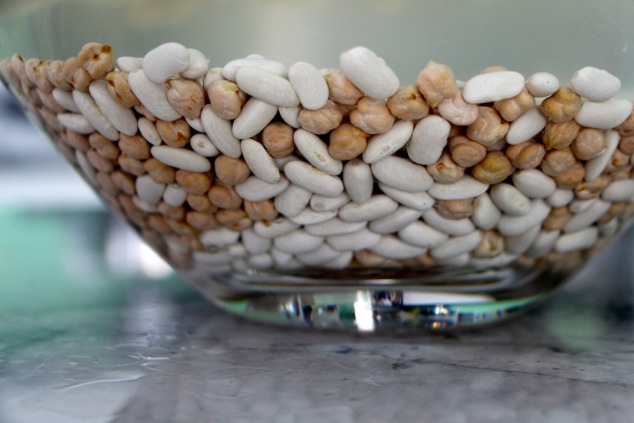 This dish requires some planning, so we actually going to start it couple of days before it will be served…
This dish requires some planning, so we actually going to start it couple of days before it will be served…
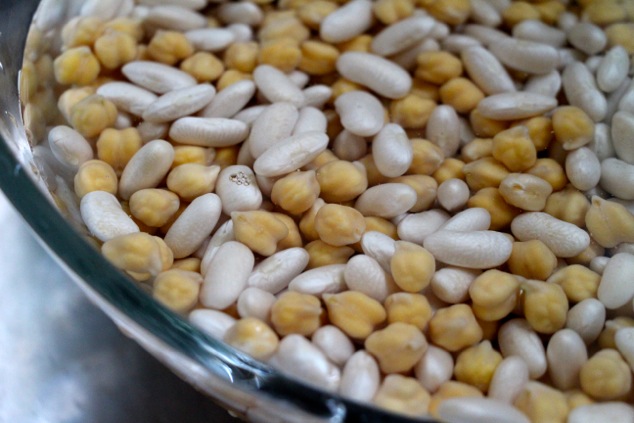 Start by soaking the beans and chickpeas in cold water overnight or for at least 12 hours. The motto here is kind of “the longer the better”…just so you know they can be soaked a little over 24 hours… You also need to change their water a few times during the soaking process. Your sign can be when the water turns a little yellowish or just do it every few hours.
Start by soaking the beans and chickpeas in cold water overnight or for at least 12 hours. The motto here is kind of “the longer the better”…just so you know they can be soaked a little over 24 hours… You also need to change their water a few times during the soaking process. Your sign can be when the water turns a little yellowish or just do it every few hours.
Soak the wheat berries in water for couple of hours.
Peeling the shallots while keeping them a whole can become frustrating, the best way I know is to cut a little of its ‘head’, create another cut to the side and remove couple of the first layers.
Start with a big pot and the olive oil on low heat then add the shallots. Peel the potatoes and add them as well.
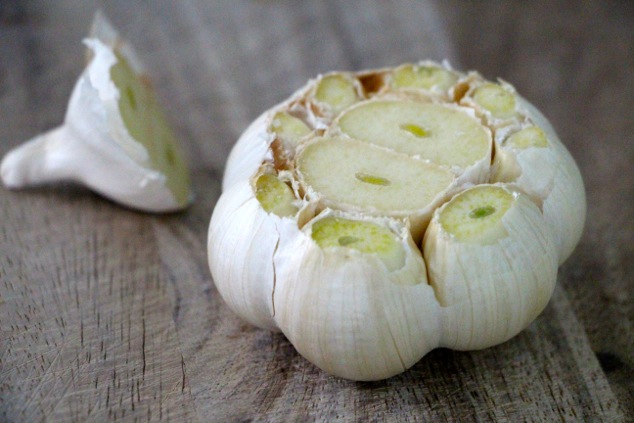 Continue with the head of garlic, we are going to use it whole. Even though we do not need to wash it, make sure it is clean by checking the bottom and removing a few of its external layers. Cut a little of its top to expose the cloves and add to the pot.
Continue with the head of garlic, we are going to use it whole. Even though we do not need to wash it, make sure it is clean by checking the bottom and removing a few of its external layers. Cut a little of its top to expose the cloves and add to the pot.
To retrieve the most flavors out of the garlic, I like to add it facing down just for 30 second and then flip it up.
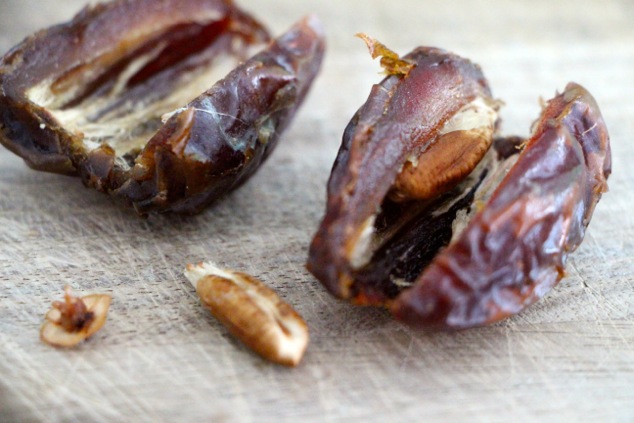 Remove pit from both dates and add to the pot.
Remove pit from both dates and add to the pot.
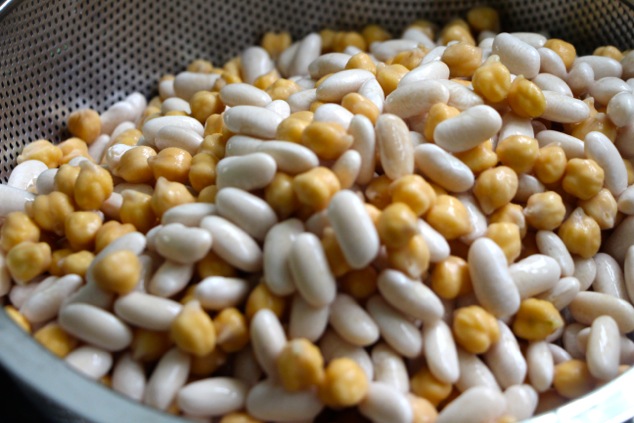
drain the beans and chickpeas
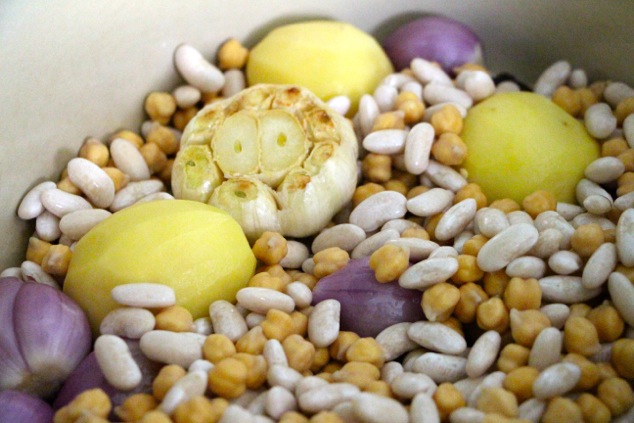 Time to add the beans and chickpeas: I find it is best to have them at the bottom of the pot, so move the shallots, potatoes, garlic head and dates to the top as you add the bean to the pot.
Time to add the beans and chickpeas: I find it is best to have them at the bottom of the pot, so move the shallots, potatoes, garlic head and dates to the top as you add the bean to the pot.
Add the spices and the Harissa excluding the salt – we will add it at the very end right before we send our Hamin to the oven.
Add water just enough to cover and a little over the pot dwellers. Bring to a boil and let it boil for five minutes. After that you may low the heat and at this stage you can add wheat berries in the cooking bag and the half boiled eggs.
Let’s talk about the “Hita” -wheat berries dish:
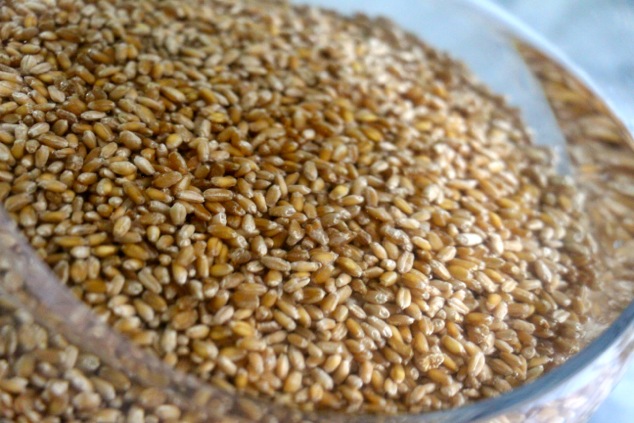
After the wheat berries have been soaked in water for couple of hours, drain them and add to the cooking bag. We are going to echo the flavors of the Hamin, so start by adding 3 cloves of garlic. Chop half a shallot and add it in together with spices.
Add the little olive oil and water and tie the bag at the top. Tilt the bag a few times to mix everything well. Using your knife poke two or three small holes at the top of the bag close to the knot. Add the bag to the pot and make sure the top part with the poked wholes is under the water surface.
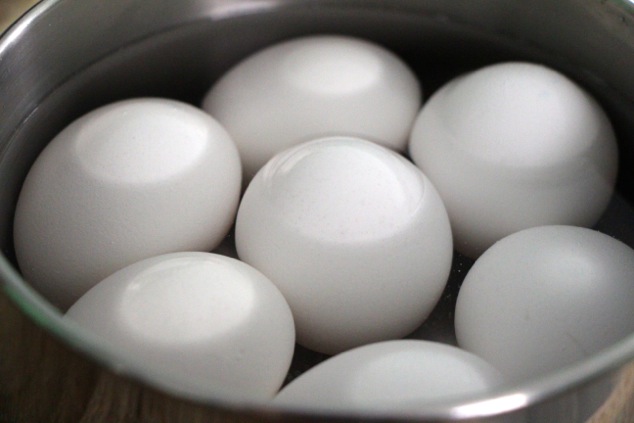 I like to pre-boil the eggs just for a few minutes on low heat before I add them to the Hamin. After adding the cooking bag you may carefully add the eggs around.
I like to pre-boil the eggs just for a few minutes on low heat before I add them to the Hamin. After adding the cooking bag you may carefully add the eggs around.
I think we got everything in (just not the salt yet).
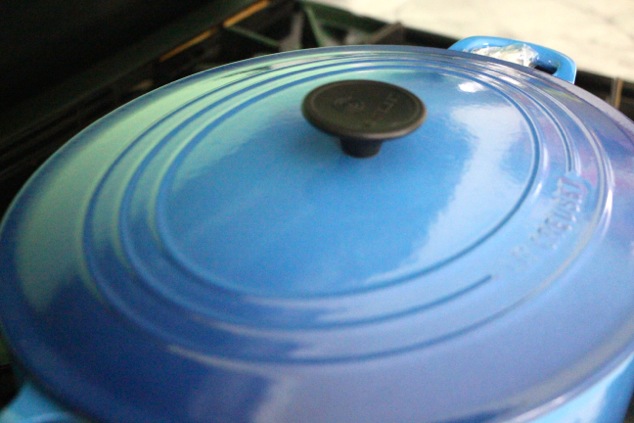 Cover the pot and cook with a low simmer for 45 minutes. Right before the oven, add the salt in and mix lightly for even spread. Transfer the covered pot to 225° preheated oven for at least 12 hours. While the Hamin is in the oven you may check couple of times to see whether you may need to add a little more water… I usually don’t need to add any…
Cover the pot and cook with a low simmer for 45 minutes. Right before the oven, add the salt in and mix lightly for even spread. Transfer the covered pot to 225° preheated oven for at least 12 hours. While the Hamin is in the oven you may check couple of times to see whether you may need to add a little more water… I usually don’t need to add any…
 When the Hamin is ready in the morning its aroma surrounds the whole house and actually calls me to open the oven and see what’s going on …
When the Hamin is ready in the morning its aroma surrounds the whole house and actually calls me to open the oven and see what’s going on …
Before serving the Hamin, take out the eggs, peel them and serve them in a separate serving dish on the side.
Carefully take out the cooking bag, open it and move into a serving bowl.
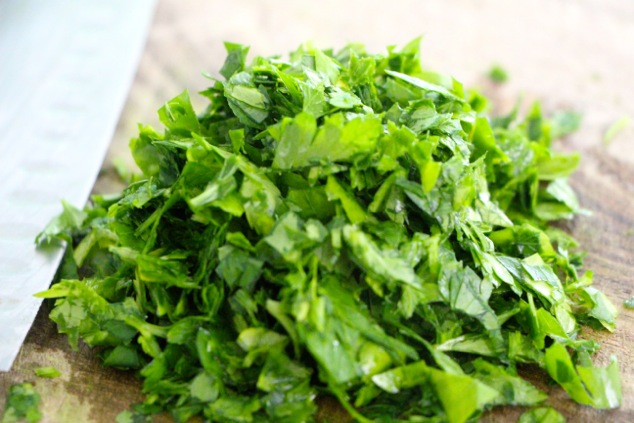
 Top with freshly chopped parsley, it will brighten up the depth of this long cooked dish’s flavors.
Top with freshly chopped parsley, it will brighten up the depth of this long cooked dish’s flavors.
Even though served in separate serving dishes, you totally have my blessing to eat them all together on one plate/bowl. 🙂
—————————————————————————
Quick Recipe:
Hamin Shabbat T’fina-
To a big pot with olive oil add Shallots, Potatoes and Garlic head.
Add soaked and drained Beans and Chickpeas to the bottom.
Add Black Pepper, Cumin, Turmeric, Sweet Paprika, Harissa (optional).
Add Water enough to go over all the ingredients.
Bring to a boil and allow boiling for 5 minutes.
Reduce heat to low keeping a low simmer.
Add Cooking Bag with Hita and pre-boiled Eggs.
Cover and cook for 45 minutes.
Transfer Hamin pot to 225° preheated oven for at least 12 hours.
“Hita” in Cooking Bag-
Put soaked and drained Wheat Berries into cooking bag.
Add chopped Shallot and Garlic cloves.
Add all spices, Olive Oil and Water.
Tie the bag and tilt to mix everything well.
Poke two or three small holes at the top of the bag close to the knot.
*When adding “Hita” to pot make sure the Hamin liquids cover the bag’s holes at the top.
* When serving, transfer Eggs and Hita into separate serving dishes.

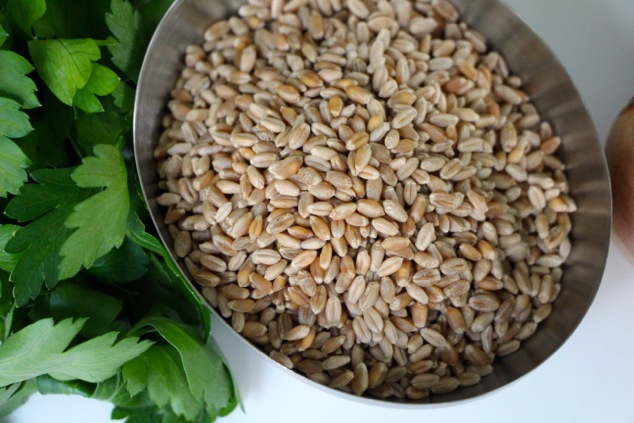
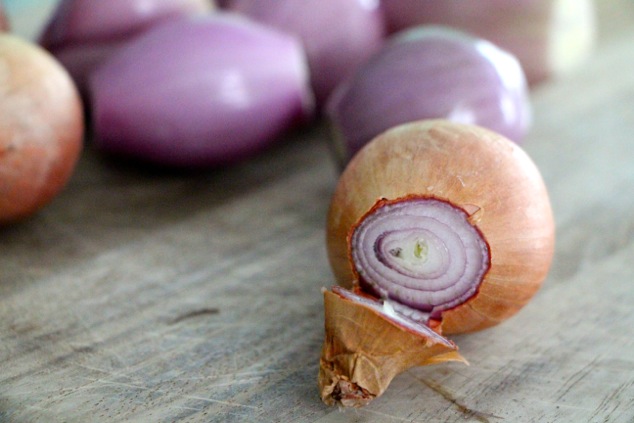
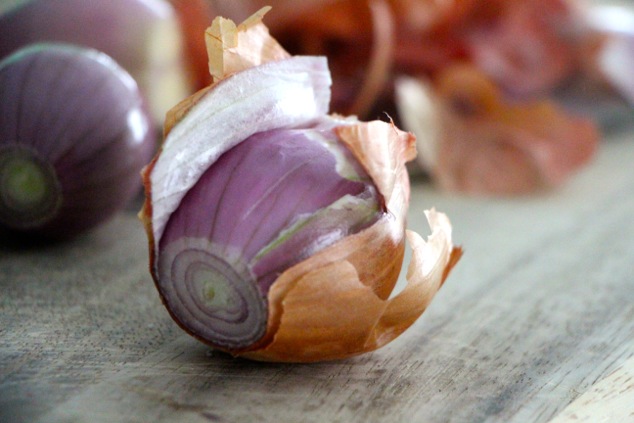
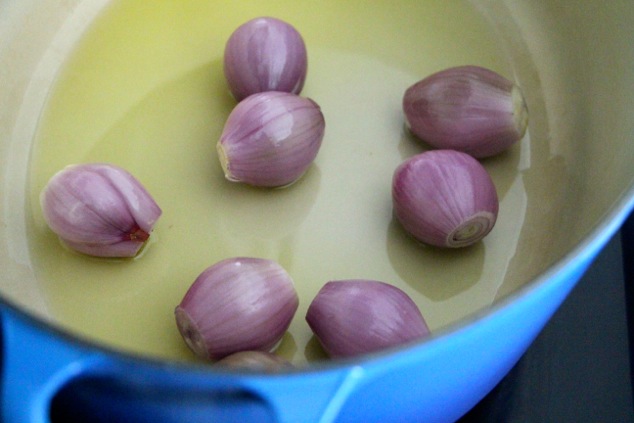
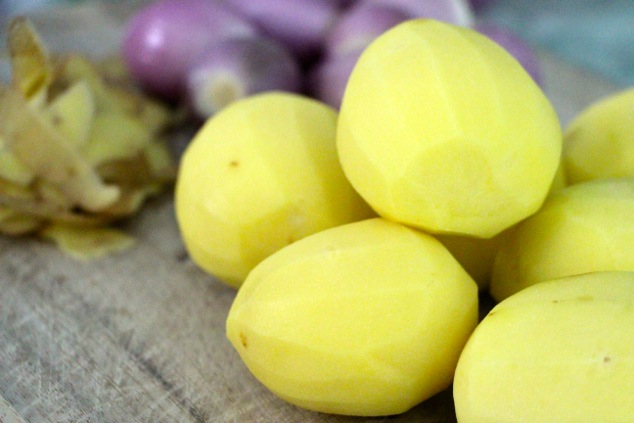
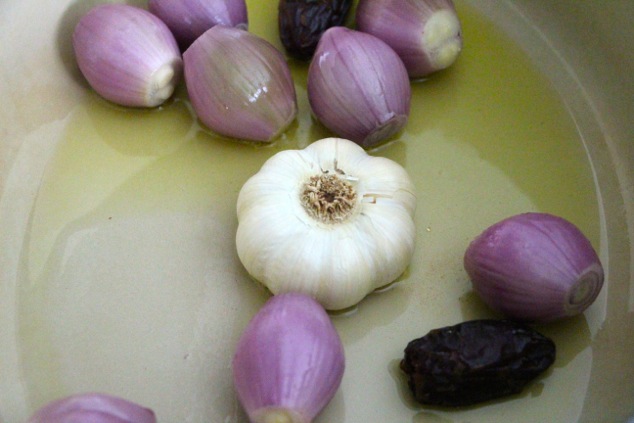
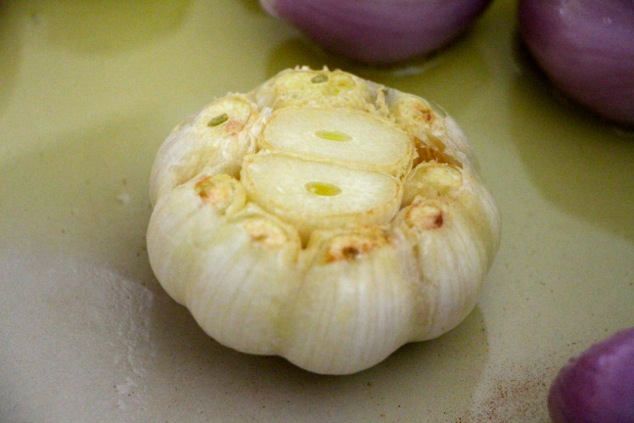
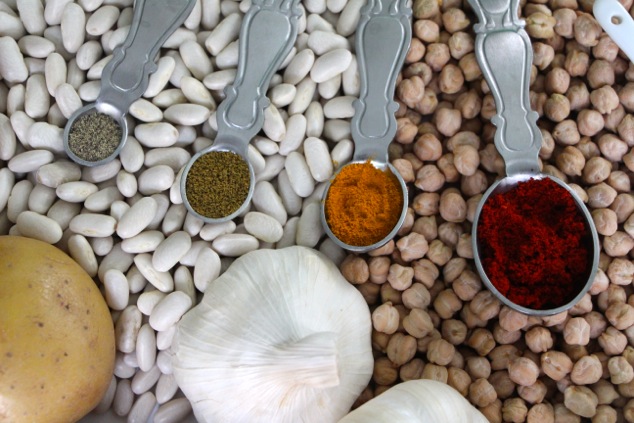
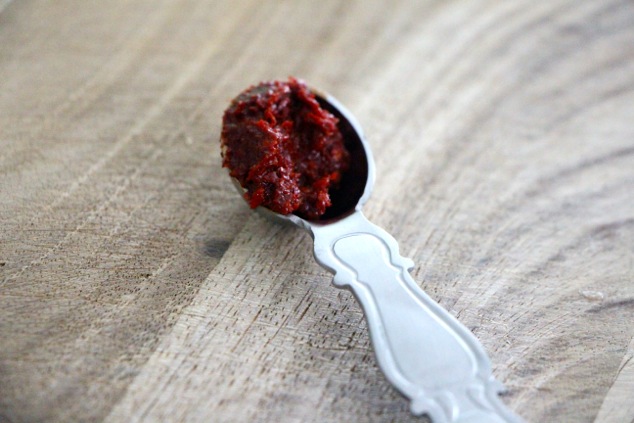
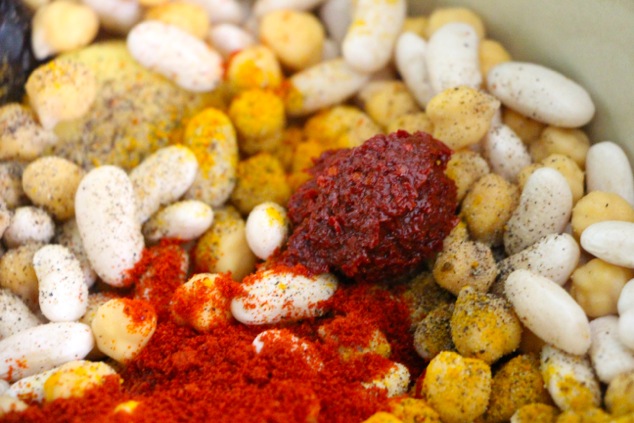
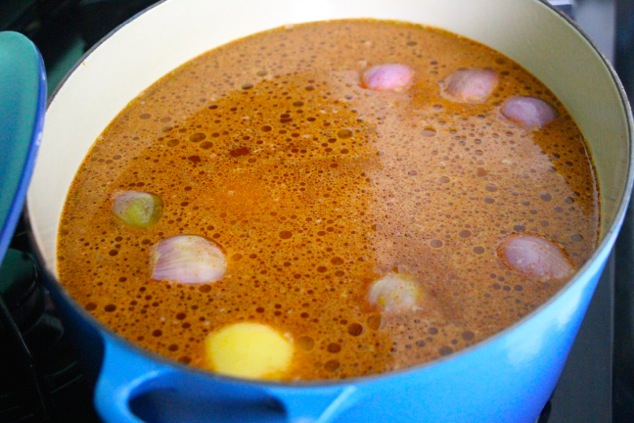
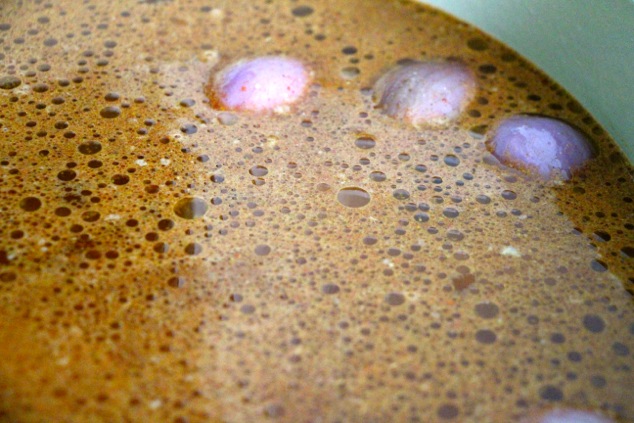
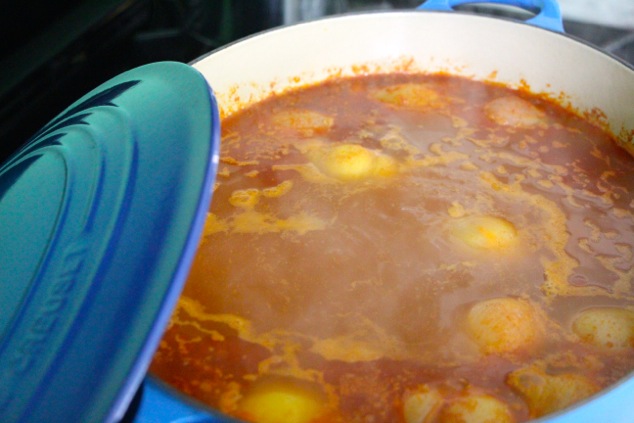
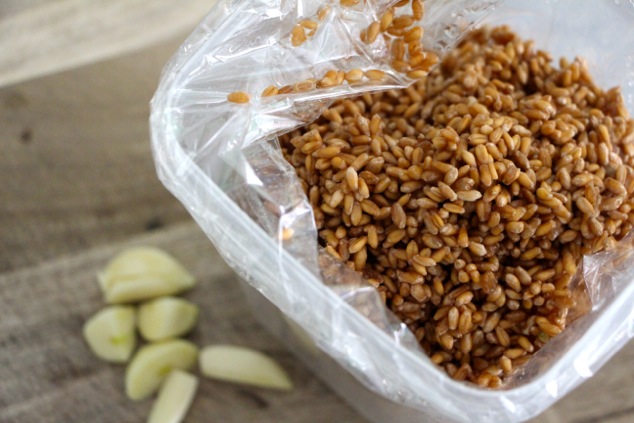
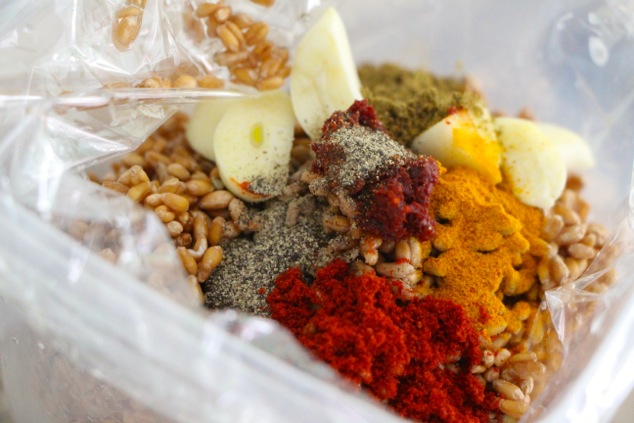
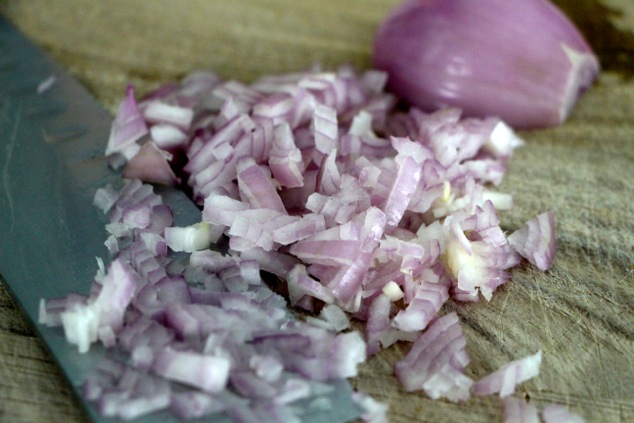
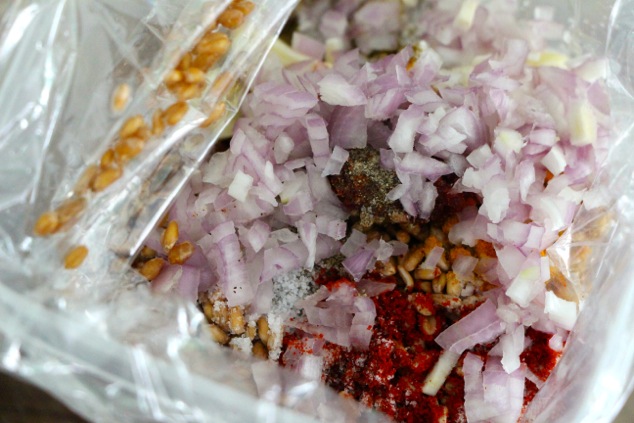
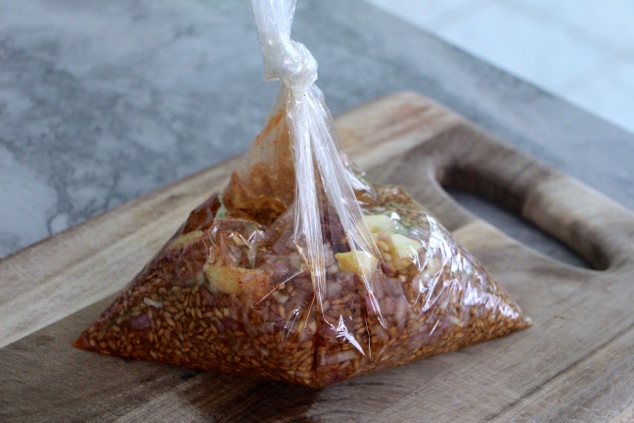
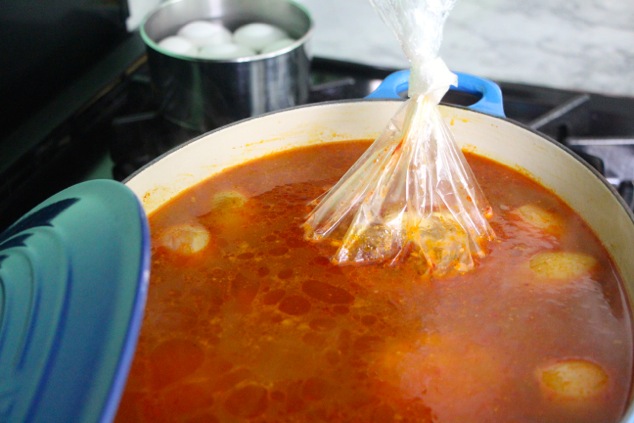
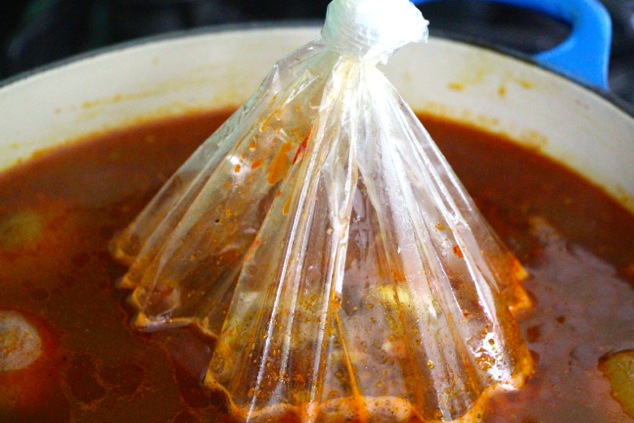
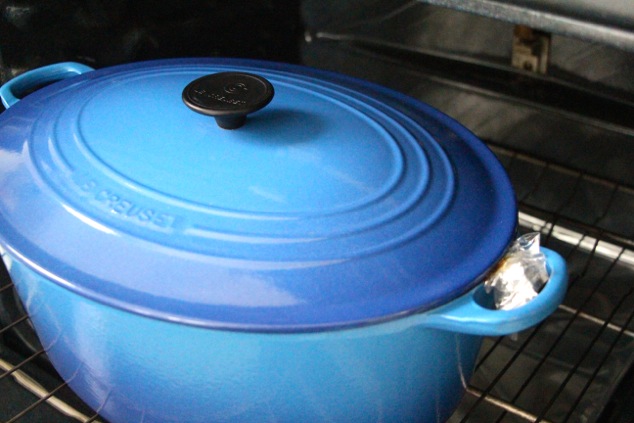

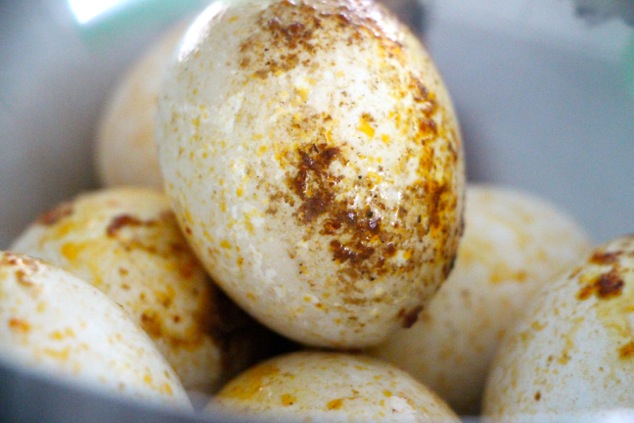
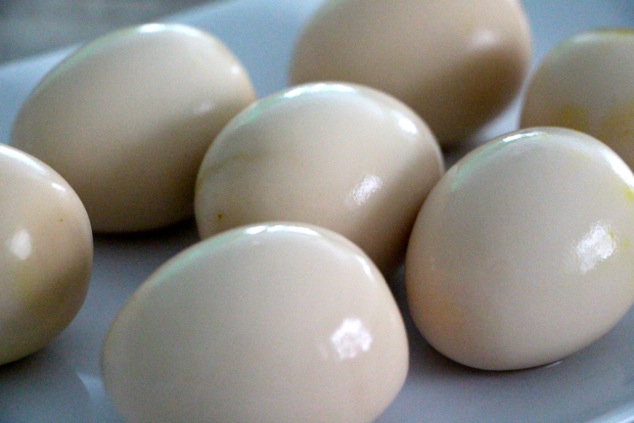
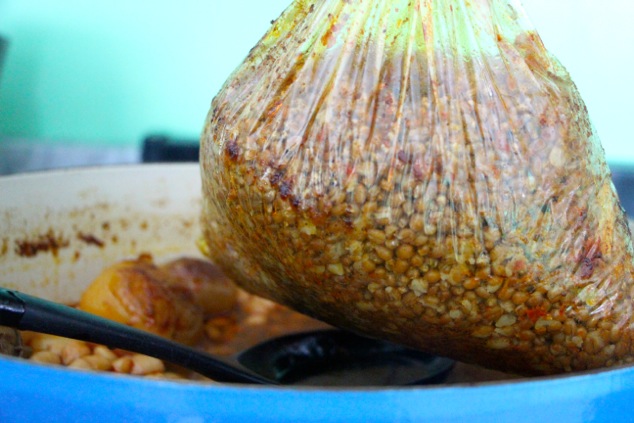
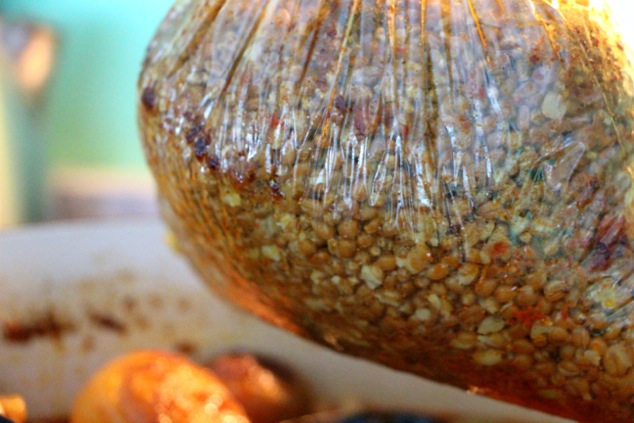
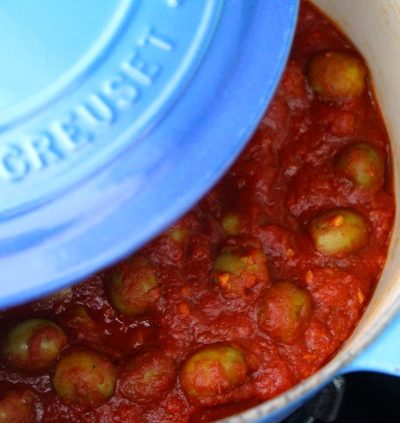
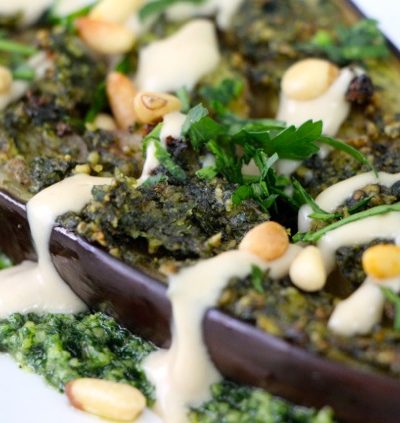
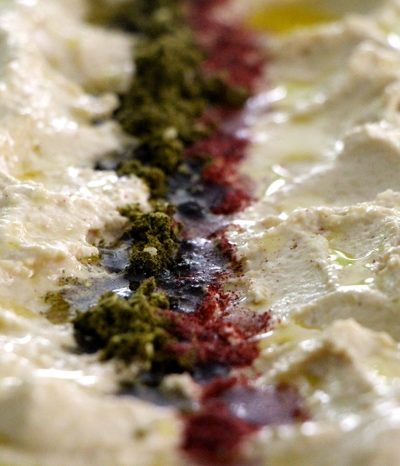
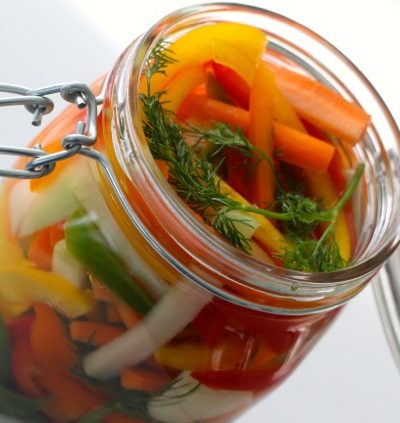
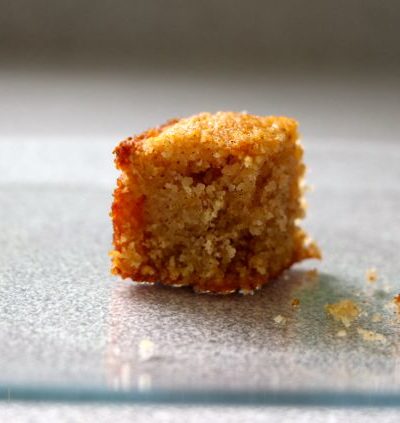
Thank you for this! So many good ideas. Consider cheesecloth instead of the bag– the flavors can mix and you aren’t using plastic 🙂
Thank you Batya! I appreciate your thought. Indeed cheesecloth is on my mind theses days even with the Hamin that is so associated with a cooking bag…the more I use it, the more I warm up to the idea. I will definitely update the post with some new photos of this preferred method.
Have you tried it with cheese cloth yet?
Hi Leah,
I did try it with the cheesecloth. I had to add a little more water and change up some of the spices amounts, but it came out ok. I just still rather it in the cooking bag. It may be a matter of habit, but it also since the cheesecloth does not separate it completely from the Hamin especially when it comes to the liquids and spices. with the cheesecloth the liquids and spices are shared, it is hard to control the individual flavor of each dish and I’m less used to that… Personally, I feel comfortable using cooking bags that are purposed for these tasks and especially since it is cooked in such low temperatures. But I will conclude that both work well, so go with your guts.
So, the first time I made this (yesterday), I found that the beans were quite done after about 3-4 hours, and that 6-8 hours made them the approximate consistency of baby food—very mushy and falling apart. I would suggest skipping the soak, especially since the beans are baked and will cook more evenly because of it. Even still, if your beans are a relatively new crop, don’t expect them to hold up this long.
If health permits, I would recommend increasing the amount of salt (e.g., salt the bean soaking water if used), since the potatoes are salt sponges. Regardless, I would also be slightly more generous with the pot spices, fry them a bit before adding the water, and slice up some of the shallots. To amp up the flavor some more, you can also use the bean soaking water (if you soak) to cook the beans.
I made the hita with millet instead of wheat berries (happy Pesach!) and used a cloth cooking bag—it turned out delicious!
Hey Sarah, I’m glad you gave the Hamin a try. I’m surprised to hear your beans did not keep their shape; even though they become very soft they always kept their shape for us. I make Hamin very often and have been using this method with many other bean dishes- they always kept their shape. Perhaps your boiling stage was too long? or it was too crowded in the pot for the beans and they were pushed against other ingredients…??? I would never recommend not to soak the beans all together-it is a very important stage. Also check the timing; the recipe indicates to bring the pot to a boil, low simmer for 45 minutes and then send to a low oven (225) over night- all standard timing for Hamin/Cholent. As far as salt level and spiciness I’m glad you found the amounts that please your palate and I also think a cloth bag is great as well. Keep up the good work!
Hi ! can I do the same recipe in the slow cooker?
Thank you!
Dear Ronit,
Even though I haven’t tried it myself, I believe it will definitely work in a slow cooker.
Go for it, give it a try and let me know how it turned out.
Good Luck,
Huppit
Thanks for the recipe! Do you think it could work cooking it in a Dutch oven on a plata overnight instead of in the oven?
Dear Ilana,
Thank you for your question. This dish will definitely work well in Dutch oven over a plata. However, if you have access to an oven even if not for the whole process, it will be beneficial to “start” your pot in the oven even if for 1-2 hours before moving it to the plata. Since the plata does not provide the same oven environment,you might need to keep the pot a little longer on the plata then the oven time.
Hope I was able to help, please let me know how it worked out
Huppit
Can You advise cooking the hamin with marrow bones and short ribs and how to? I what do you think of adding cinnamon?
Thanks
Hana
Hi Hanna,
Adding marrow bones and short ribs to your Hamin will add a lot of flavor! For that, when you are in the very initial stage of adding the oil to the pot, warm it up to medium-high level, add the marrow bone and meat pieces and allow them to sear quickly on all sides. remove from the pot and set aside. continue with all the following steps as mentioned in the Hamin recipe. Add back the seared marrow bone and meat pieces right before you add the water to the pot. make sure to locate them in the middle of your pot so they are surrounded by the beans and vegetables and do not dry on the top while liquid is reduced slightly during the slow cooking process.
Regarding adding cinnamon to the Hamin- it is very common in Moroccan dishes including Hamin, some other North African cuisines use cinnamon as well and even a few areas in Tunisia may include it in some savory dishes. Having said that, mostly and traditionally, cinnamon is not included in Tunisian savory dishes. Of course if you and your family like the taste of cinnamon, try to add a little to see if you like it. (I wouldn’t add too much as cinnamon can have an overwhelming flavor)
Enjoy and let me know how you liked it!
Huppit